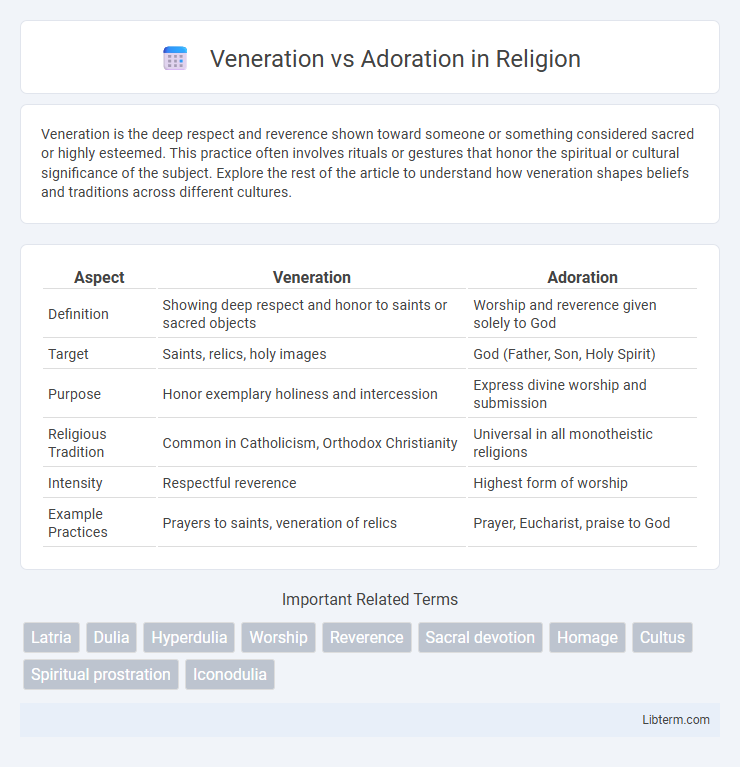Veneration is the deep respect and reverence shown toward someone or something considered sacred or highly esteemed. This practice often involves rituals or gestures that honor the spiritual or cultural significance of the subject. Explore the rest of the article to understand how veneration shapes beliefs and traditions across different cultures.
Table of Comparison
| Aspect | Veneration | Adoration |
|---|---|---|
| Definition | Showing deep respect and honor to saints or sacred objects | Worship and reverence given solely to God |
| Target | Saints, relics, holy images | God (Father, Son, Holy Spirit) |
| Purpose | Honor exemplary holiness and intercession | Express divine worship and submission |
| Religious Tradition | Common in Catholicism, Orthodox Christianity | Universal in all monotheistic religions |
| Intensity | Respectful reverence | Highest form of worship |
| Example Practices | Prayers to saints, veneration of relics | Prayer, Eucharist, praise to God |
Defining Veneration and Adoration
Veneration refers to the deep respect and honor given to saints, relics, or sacred objects within various religious traditions, recognizing their holiness without equating them to the divine. Adoration, in contrast, is the act of worshiping God alone with profound love and reverence, acknowledging His supreme divinity and sovereignty. While veneration involves honoring holy figures as intercessors, adoration is reserved exclusively for the worship of God.
Historical Roots of Veneration and Adoration
Veneration and adoration have distinct historical roots in religious practices, with veneration tracing back to ancient traditions of honoring saints, relics, and sacred objects as intermediaries to the divine, especially prominent in early Christianity and Eastern Orthodoxy. Adoration, conversely, is reserved exclusively for the worship of God alone, rooted in monotheistic traditions emphasizing direct divine reverence without intermediaries. This differentiation evolved through theological developments in the early Church councils and Christian liturgical practices, defining the boundaries between respect for holy figures and ultimate worship of the divine essence.
Theological Distinctions Explained
Veneration and adoration differ fundamentally in Christian theology, where adoration (latria) is the highest form of worship reserved exclusively for God, reflecting divine honor and submission. Veneration (dulia) is a respectful homage given to saints and holy objects, acknowledging their exemplary holiness without attributing divine status. This distinction maintains the monotheistic worship of God while honoring the sanctity of saints as intercessors and models of faith.
Veneration in Religious Practices
Veneration in religious practices involves showing deep respect and honor to saints, relics, or sacred images without attributing divinity, distinguishing it from adoration, which is reserved solely for God. This form of reverence plays a crucial role in Catholic, Orthodox, and some Anglican traditions, serving as a means to inspire faith and spiritual connection. Rituals such as bowing, lighting candles, or praying before icons exemplify veneration, emphasizing respect without crossing into worship.
Adoration in Worship Traditions
Adoration in worship traditions represents the highest form of reverence directed exclusively to the divine, emphasizing deep love, devotion, and awe toward God. Unlike veneration, which honors saints or sacred objects as intermediaries, adoration involves direct spiritual worship expressing unconditional submission and praise. This distinction underscores the unique role of adoration in practices such as Eucharistic worship and prayer, where the divine presence is central to faith experience.
Key Differences Between Veneration and Adoration
Veneration involves showing deep respect and honor towards saints, relics, or sacred objects without worshiping them as divine. Adoration is reserved solely for divine beings, such as God, and entails worship, reverence, and acknowledgment of supreme divinity. The key difference lies in the level of reverence: veneration acknowledges holiness or sanctity, while adoration expresses ultimate worship and devotion to God alone.
Common Misconceptions and Clarifications
Veneration and adoration are often mistakenly used interchangeably, but they represent distinct practices within religious contexts. Veneration involves showing deep respect and honor to saints or sacred objects, without implying divine worship, whereas adoration is reserved exclusively for the worship of God. Clarifying this distinction helps prevent theological confusion and ensures accurate expressions of faith.
The Role of Saints and Icons in Veneration
Veneration involves showing deep respect and honor to saints and icons, recognizing their exemplary faith and spiritual significance without equating them with divine worship. Saints are regarded as intercessors who pray on behalf of believers, while icons serve as tangible representations that inspire devotion and remind the faithful of holy virtues. This practice differentiates from adoration, which is reserved exclusively for God, emphasizing a clear theological distinction within Christian worship traditions.
Adoration in Christian Liturgical Contexts
Adoration in Christian liturgical contexts signifies the profound worship and reverence given exclusively to God, acknowledging His supreme divinity and sovereignty. Unlike veneration, which honors saints and sacred objects as mediators and examples of faith, adoration is reserved for the Holy Trinity, reflecting ultimate devotion and submission. This practice is central to the Eucharistic celebration, where the real presence of Christ in the Blessed Sacrament is solemnly adored by the faithful.
The Impact of Veneration and Adoration on Faith Communities
Veneration and adoration play pivotal roles in shaping faith communities by fostering deep spiritual connections and collective identity among believers. Veneration, often directed toward saints or sacred objects, encourages communal respect and tradition preservation, while adoration focuses solely on worshiping the divine, intensifying personal devotion. Both practices significantly enhance religious experience, promoting unity and strengthening the cultural and theological fabric within faith communities.
Veneration Infographic

 libterm.com
libterm.com